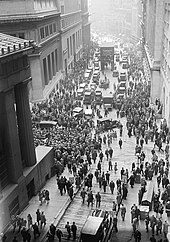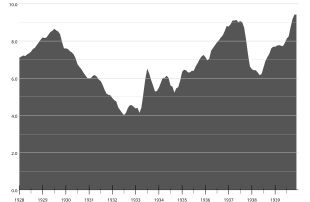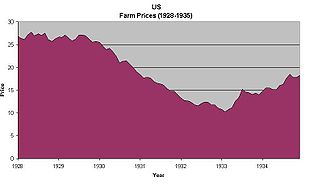Great Depression
From Wikipedia, the free encyclopedia
This article is about the severe worldwide economic downturn in the 1930s. For other uses, see The Great Depression (disambiguation).

Dorothea Lange's Migrant Mother depicts destitute pea pickers in California, centering on Florence Owens Thompson, age 32, a mother of seven children, in Nipomo, California, March 1936.
The Great Depression had devastating effects in virtually every country, rich and poor. Personal income, tax revenue, profits and prices dropped, while international trade plunged by more than 50%. Unemployment in the U.S. rose to 25%, and in some countries rose as high as 33%.[3] Cities all around the world were hit hard, especially those dependent on heavy industry. Construction was virtually halted in many countries. Farming and rural areas suffered as crop prices fell by approximately 60%.[4][5][6] Facing plummeting demand with few alternate sources of jobs, areas dependent on primary sector industries such as cash cropping, mining and logging suffered the most.[7]
Some economies started to recover by the mid-1930s; in many countries the negative effects of the Great Depression lasted until the start of World War II.[8]
Contents[hide] |
Start of the Great Depression
See also: Timeline of the Great Depression
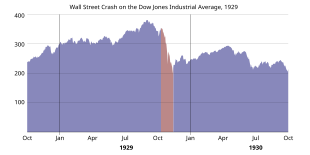
Dow Jones Industrial, 1928–1930
By mid-1930, interest rates had dropped to low levels, but expected deflation and the continuing reluctance of people to borrow meant that consumer spending and investment were depressed.[13] By May 1930, automobile sales had declined to below the levels of 1928. Prices in general began to decline, although wages held steady in 1930; but then a deflationary spiral started in 1931. Conditions were worse in farming areas, where commodity prices plunged, and in mining and logging areas, where unemployment was high and there were few other jobs. The decline in the US economy was the factor that pulled down most other countries at first, then internal weaknesses or strengths in each country made conditions worse or better. Frantic attempts to shore up the economies of individual nations through protectionist policies, such as the 1930 U.S. Smoot–Hawley Tariff Act and retaliatory tariffs in other countries, exacerbated the collapse in global trade. By late 1930, a steady decline in the world economy had set in, which did not reach bottom until 1933.
Economic indicators
Change in economic indicators 1929–32[14]| United States | Great Britain | France | Germany | |
|---|---|---|---|---|
| Industrial production | –46% | –23% | –24% | –41% |
| Wholesale prices | –32% | –33% | –34% | –29% |
| Foreign trade | –70% | –60% | –54% | –61% |
| Unemployment | +607% | +129% | +214% | +232% |
Causes
Main article: Causes of the Great Depression
There were multiple causes for the first downturn in 1929. These
include the structural weaknesses and specific events that turned it
into a major depression and the manner in which the downturn spread from
country to country. In relation to the 1929 downturn, historians
emphasize structural factors like major bank failures and the stock
market crash. In contrast, economists (such as Barry Eichengreen, Milton Friedman and Peter Temin) point to monetary factors such as actions by the US Federal Reserve that contracted the money supply, as well as Britain's decision to return to the Gold Standard at pre–World War I parities (US$4.86:£1).Recessions and business cycles are thought to be a normal part of living in a world of inexact balances between supply and demand. What turns a normal recession or 'ordinary' business cycle into a depression is a subject of much debate and concern. Scholars have not agreed on the exact causes and their relative importance. The search for causes is closely connected to the issue of avoiding future depressions.
Thus, the personal political and policy viewpoints of scholars greatly color their analysis of historic events occurring eight decades ago. An even larger question is whether the Great Depression was primarily a failure on the part of free markets or a failure of government efforts to regulate interest rates, curtail widespread bank failures, and control the money supply. Those who believe in a larger economic role for the state believe that it was primarily a failure of free markets, while those who believe in a smaller role for the state believe that it was primarily a failure of government that compounded the problem.
Current theories may be broadly classified into two main points of view and several heterodox points of view. First, there are demand-driven theories, most importantly Keynesian economics, but also including those who point to the breakdown of international trade, and Institutional economists who point to underconsumption and over-investment (causing an economic bubble), malfeasance by bankers and industrialists, or incompetence by government officials. The consensus among demand-driven theories is that a large-scale loss of confidence led to a sudden reduction in consumption and investment spending. Once panic and deflation set in, many people believed they could avoid further losses by keeping clear of the markets. Holding money became profitable as prices dropped lower and a given amount of money bought ever more goods, exacerbating the drop in demand.
Secondly, there are the monetarists, who believe that the Great Depression started as an ordinary recession, but that significant policy mistakes by monetary authorities (especially the Federal Reserve), caused a shrinking of the money supply which greatly exacerbated the economic situation, causing a recession to descend into the Great Depression. Related to this explanation are those who point to debt deflation causing those who borrow to owe ever more in real terms.
Lastly, there are various heterodox theories that downplay or reject the explanations of the Keynesians and monetarists. For example, some new classical macroeconomists have argued that various labor market policies imposed at the start caused the length and severity of the Great Depression. The Austrian school of economics focuses on the macroeconomic effects of money supply, and how central banking decisions can lead to over-investment (economic bubble).
Demand-driven
Keynesian
British economist John Maynard Keynes argued in General Theory of Employment Interest and Money that lower aggregate expenditures in the economy contributed to a massive decline in income and to employment that was well below the average. In such a situation, the economy reached equilibrium at low levels of economic activity and high unemployment. Keynes' basic idea was simple: to keep people fully employed, governments have to run deficits when the economy is slowing, as the private sector would not invest enough to keep production at the normal level and bring the economy out of recession. Keynesian economists called on governments during times of economic crisis to pick up the slack by increasing government spending and/or cutting taxes.As the Depression wore on, Franklin D. Roosevelt tried public works, farm subsidies, and other devices to restart the US economy, but never completely gave up trying to balance the budget. According to the Keynesians, this improved the economy, but Roosevelt never spent enough to bring the economy out of recession until the start of World War II.[15]
Breakdown of international trade
Many economists have argued that the sharp decline in international trade after 1930 helped to worsen the depression, especially for countries significantly dependent on foreign trade. Most historians and economists partly blame the American Smoot-Hawley Tariff Act (enacted June 17, 1930) for worsening the depression by seriously reducing international trade and causing retaliatory tariffs in other countries. While foreign trade was a small part of overall economic activity in the U.S. and was concentrated in a few businesses like farming, it was a much larger factor in many other countries.[16] The average ad valorem rate of duties on dutiable imports for 1921–1925 was 25.9% but under the new tariff it jumped to 50% in 1931–1935.In dollar terms, American exports declined from about $5.2 billion in 1929 to $1.7 billion in 1933; but prices also fell, so the physical volume of exports only fell by half. Hardest hit were farm commodities such as wheat, cotton, tobacco, and lumber. According to this theory, the collapse of farm exports caused many American farmers to default on their loans, leading to the bank runs on small rural banks that characterized the early years of the Great Depression.
Debt deflation
Irving Fisher argued that the predominant factor leading to the Great Depression was over-indebtedness and deflation. Fisher tied loose credit to over-indebtedness, which fueled speculation and asset bubbles.[17] He then outlined 9 factors interacting with one another under conditions of debt and deflation to create the mechanics of boom to bust. The chain of events proceeded as follows:- Debt liquidation and distress selling
- Contraction of the money supply as bank loans are paid off
- A fall in the level of asset prices
- A still greater fall in the net worths of business, precipitating bankruptcies
- A fall in profits
- A reduction in output, in trade and in employment.
- Pessimism and loss of confidence
- Hoarding of money
- A fall in nominal interest rates and a rise in deflation adjusted interest rates.[17]

Crowds outside the Bank of United States after its failure in 1931.
Bank failures snowballed as desperate bankers called in loans which the borrowers did not have time or money to repay. With future profits looking poor, capital investment and construction slowed or completely ceased. In the face of bad loans and worsening future prospects, the surviving banks became even more conservative in their lending.[19] Banks built up their capital reserves and made fewer loans, which intensified deflationary pressures. A vicious cycle developed and the downward spiral accelerated.
The liquidation of debt could not keep up with the fall of prices which it caused. The mass effect of the stampede to liquidate increased the value of each dollar owed, relative to the value of declining asset holdings. The very effort of individuals to lessen their burden of debt effectively increased it. Paradoxically, the more the debtors paid, the more they owed.[17] This self-aggravating process turned a 1930 recession into a 1933 great depression.
Macroeconomists including Ben Bernanke, the current chairman of the U.S. Federal Reserve Bank, have revived the debt-deflation view of the Great Depression originated by Fisher.[21][22]
Monetarist
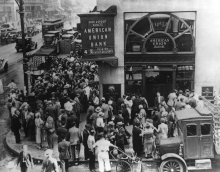
Crowd at New York's American Union Bank during a bank run early in the Great Depression.
One reason why the Federal Reserve did not act to limit the decline of the money supply was regulation. At that time, the amount of credit the Federal Reserve could issue was limited by the Federal Reserve Act, which required 40% gold backing of Federal Reserve Notes issued. By the late 1920s, the Federal Reserve had almost hit the limit of allowable credit that could be backed by the gold in its possession. This credit was in the form of Federal Reserve demand notes. A "promise of gold" is not as good as "gold in the hand", particularly when they only had enough gold to cover 40% of the Federal Reserve Notes outstanding. During the bank panics a portion of those demand notes were redeemed for Federal Reserve gold. Since the Federal Reserve had hit its limit on allowable credit, any reduction in gold in its vaults had to be accompanied by a greater reduction in credit. On April 5, 1933, President Roosevelt signed Executive Order 6102 making the private ownership of gold certificates, coins and bullion illegal, reducing the pressure on Federal Reserve gold.[28]
New classical approach
Recent work from a neoclassical perspective focuses on the decline in productivity that caused the initial decline in output and a prolonged recovery due to policies that affected the labor market. This work, collected by Kehoe and Prescott,[29] decomposes the economic decline into a decline in the labor force, capital stock, and the productivity with which these inputs are used. This study suggests that theories of the Great Depression have to explain an initial severe decline but rapid recovery in productivity, relatively little change in the capital stock, and a prolonged depression in the labor force. This analysis rejects theories that focus on the role of savings and posit a decline in the capital stock.Austrian School
Another explanation comes from the Austrian School of economics. Theorists of the "Austrian School" who wrote about the Depression include Austrian economist Friedrich Hayek and American economist Murray Rothbard, who wrote America's Great Depression (1963). In their view and like the monetarists, the Federal Reserve, which was created in 1913, shoulders much of the blame; but in opposition to the monetarists, they argue that the key cause of the Depression was the expansion of the money supply in the 1920s that led to an unsustainable credit-driven boom. In the Austrian view it was this inflation of the money supply that led to an unsustainable boom in both asset prices (stocks and bonds) and capital goods. By the time the Fed belatedly tightened in 1928, it was far too late and, in the Austrian view, a significant economic contraction was inevitable. According to the Austrians, the artificial interference in the economy was a disaster prior to the Depression, and government efforts to prop up the economy after the crash of 1929 only made things worse. According to Rothbard, government intervention delayed the market's adjustment and made the road to complete recovery more difficult.[30] However, Hayek, unlike Rothbard, also believed, along with the monetarists, that the Federal Reserve further contributed to the problems of the Depression by permitting the money supply to shrink during the earliest years of the Depression[31].Marxist
Karl Marx saw recession and depression as unavoidable under free-market capitalism as there are no restrictions on accumulations of capital other than the market itself. In the Marxist view, capitalism tends to create unbalanced accumulations of wealth, leading to over-accumulations of capital which inevitably lead to a crisis. This especially sharp bust is a regular feature of the boom and bust pattern of what Marxists term "chaotic" capitalist development. It is a tenet of many Marxists groupings that such crises are inevitable and will be increasingly severe until the contradictions inherent in the mismatch between the mode of production and the development of productive forces reach the final point of failure. At which point, the crisis period encourages intensified class conflict and forces societal change.[32]Inequality
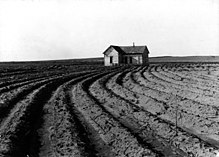
Power farming displaces tenants from the land in the western dry cotton area. Childress County, Texas, 1938.
According to this view, the root cause of the Great Depression was a global over-investment in heavy industry capacity compared to wages and earnings from independent businesses, such as farms. The solution was the government must pump money into consumers' pockets. That is, it must redistribute purchasing power, maintain the industrial base, but re-inflate prices and wages to force as much of the inflationary increase in purchasing power into consumer spending. The economy was overbuilt, and new factories were not needed. Foster and Catchings recommended[35] federal and state governments start large construction projects, a program followed by Hoover and Roosevelt.
Productivity shock
“It cannot be emphasized too strongly that the [productivity, output and employment] trends we are describing are long-time trends and were thoroughly evident prior to 1929. These trends are in nowise the result of the present depression, nor are they the result of the World War. On the contrary, the present depression is a collapse resulting from these long-term trends.” [36] M. King HubbertThe first three decades of the 20th century saw economic output surge with electrification, mass production and motorized farm machinery, and because of the rapid growth in productivity there was a lot of excess production capacity and the work week was being reduced.
The dramatic rise in productivity of major industries in the U. S. and the effects of productivity on output, wages and the work week are discussed by Spurgeon Bell in his book Productivity, Wages, and National Income (1940).[37]
Turning point and recovery

The overall course of the Depression in the United States, as reflected
in per-capita GDP (average income per person) shown in constant year
2000 dollars, plus some of the key events of the period.[38]
There is no consensus among economists regarding the motive force for the U.S. economic expansion that continued through most of the Roosevelt years (and the 1937 recession that interrupted it).
|
Roosevelt's first Fireside Chat on the Banking Crisis (March 12, 1933)
|
|
| Problems listening to this file? See media help. | |
According to Christina Romer, the money supply growth caused by huge international gold inflows was a crucial source of the recovery of the United States economy, and that the economy showed little sign of self-correction. The gold inflows were partly due to devaluation of the U.S. dollar and partly due to deterioration of the political situation in Europe.[43] In their book, A Monetary History of the United States, Milton Friedman and Anna J. Schwartz also attributed the recovery to monetary factors, and contended that it was much slowed by poor management of money by the Federal Reserve System. Current Chairman of the Federal Reserve Ben Bernanke agrees that monetary factors played important roles both in the worldwide economic decline and eventual recovery.[44] Bernanke, also sees a strong role for institutional factors, particularly the rebuilding and restructuring of the financial system,[45] and points out that the Depression needs to be examined in international perspective.[46] Economists Harold L. Cole and Lee E. Ohanian, believe that the economy should have returned to normal after four years of depression except for continued depressing influences, and point the finger to the lack of downward flexibility in prices and wages, encouraged by Roosevelt Administration policies such as the National Industrial Recovery Act.[47]
Gold standard

The Depression in international perspective.[48]
Every major currency left the gold standard during the Great Depression. Great Britain was the first to do so. Facing speculative attacks on the pound and depleting gold reserves, in September 1931 the Bank of England ceased exchanging pound notes for gold and the pound was floated on foreign exchange markets.
Great Britain, Japan, and the Scandinavian countries left the gold standard in 1931. Other countries, such as Italy and the U.S., remained on the gold standard into 1932 or 1933, while a few countries in the so-called "gold bloc", led by France and including Poland, Belgium and Switzerland, stayed on the standard until 1935–1936.
According to later analysis, the earliness with which a country left the gold standard reliably predicted its economic recovery. For example, Great Britain and Scandinavia, which left the gold standard in 1931, recovered much earlier than France and Belgium, which remained on gold much longer. Countries such as China, which had a silver standard, almost avoided the depression entirely. The connection between leaving the gold standard as a strong predictor of that country's severity of its depression and the length of time of its recovery has been shown to be consistent for dozens of countries, including developing countries. This partly explains why the experience and length of the depression differed between national economies.[52]

A female factory worker in 1942, Fort Worth, Texas. Women entered the workforce as men were drafted into the armed forces.
World War II and recovery
The common view among economic historians is that the Great Depression ended with the advent of World War II. Many economists believe that government spending on the war caused or at least accelerated recovery from the Great Depression, though some consider that it did not play a very large role in the recovery. It did help in reducing unemployment.[9][53][54]The rearmament policies leading up to World War II helped stimulate the economies of Europe in 1937–39. By 1937, unemployment in Britain had fallen to 1.5 million. The mobilization of manpower following the outbreak of war in 1939 ended unemployment.[55]
America's entry into the war in 1941 finally eliminated the last effects from the Great Depression and brought the U.S. unemployment rate down below 10%.[56] In the U.S., massive war spending doubled economic growth rates, either masking the effects of the Depression or essentially ending the Depression. Businessmen ignored the mounting national debt and heavy new taxes, redoubling their efforts for greater output to take advantage of generous government contracts.
Effects

During the Depression bankers became so unpopular that bank robbers, such as Bonnie and Clyde, became folk heroes.[57]
Australia
Main article: Great Depression in Australia
Australia's extreme dependence on agricultural and industrial exports meant it was one of the hardest-hit countries in the Western world.[58] Falling export demand and commodity prices placed massive downward pressures on wages. Further, unemployment reached a record high of 29% in 1932,[59] with incidents of civil unrest becoming common. After 1932, an increase in wool and meat prices led to a gradual recovery.Canada
Main article: Great Depression in Canada
Harshly affected by both the global economic downturn and the Dust Bowl,
Canadian industrial production had fallen to only 58% of the 1929 level
by 1932, the second lowest level in the world after the United States,
and well behind nations such as Britain, which saw it fall only to 83%
of the 1929 level. Total national income
fell to 56% of the 1929 level, again worse than any nation apart from
the United States. Unemployment reached 27% at the depth of the
Depression in 1933.[60] During the 1930s, Canada employed a highly restrictive immigration policy.[61]Chile
See also: Economic history of Chile
The League of Nations labeled Chile
the country hardest hit by the Great Depression because 80% of
government revenue came from exports of copper and nitrates, which were
in low demand. Chile initially felt the impact of the Great Depression
in 1930, when GDP dropped 14%, mining income declined 27%, and export
earnings fell 28%. By 1932, GDP had shrunk to less than half of what it
had been in 1929, exacting a terrible toll in unemployment and business
failures.Influenced profoundly by the Great Depression, many national leaders promoted the development of local industry in an effort to insulate the economy from future external shocks. After six years of government austerity measures, which succeeded in reestablishing Chile's creditworthiness, Chileans elected to office during the 1938–58 period a succession of center and left-of-center governments interested in promoting economic growth by means of government intervention.
Prompted in part by the devastating earthquake of 1939, the Popular Front government of Pedro Aguirre Cerda created the Production Development Corporation (Corporación de Fomento de la Producción, CORFO) to encourage with subsidies and direct investments an ambitious program of import substitution industrialization. Consequently, as in other Latin American countries, protectionism became an entrenched aspect of the Chilean economy.
France
Main article: Great Depression in France
The Depression began to affect France around 1931. France's
relatively high degree of self-sufficiency meant the damage was
considerably less than in nations like Germany. Hardship and
unemployment were high enough to lead to rioting and the rise of the socialist Popular Front.Germany
Main article: Great Depression in Central Europe
Germany's Weimar Republic was hit hard by the depression, as American loans to help rebuild the German economy now stopped.[62] Unemployment soared, especially in larger cities, and the political system veered toward extremism.[63] The unemployment rate reached nearly 30% in 1932.[64] Repayment of the war reparations due by Germany were suspended in 1932 following the Lausanne Conference of 1932. By that time, Germany had repaid one eighth of the reparations. Hitler's Nazi Party came to power in January 1933.Japan
The Great Depression did not strongly affect Japan. The Japanese economy shrank by 8% during 1929–31. Japan's Finance Minister Takahashi Korekiyo was the first to implement what have come to be identified as Keynesian economic policies: first, by large fiscal stimulus involving deficit spending; and second, by devaluing the currency. Takahashi used the Bank of Japan to sterilize the deficit spending and minimize resulting inflationary pressures. Econometric studies have identified the fiscal stimulus as especially effective.[65]The devaluation of the currency had an immediate effect. Japanese textiles began to displace British textiles in export markets. The deficit spending proved to be most profound. The deficit spending went into the purchase of munitions for the armed forces. By 1933, Japan was already out of the depression. By 1934, Takahashi realized that the economy was in danger of overheating, and to avoid inflation, moved to reduce the deficit spending that went towards armaments and munitions. This resulted in a strong and swift negative reaction from nationalists, especially those in the army, culminating in his assassination in the course of the February 26 Incident. This had a chilling effect on all civilian bureaucrats in the Japanese government. From 1934, the military's dominance of the government continued to grow. Instead of reducing deficit spending, the government introduced price controls and rationing schemes that reduced, but did not eliminate inflation, which would remain a problem until the end of World War II.
The deficit spending had a transformative effect on Japan. Japan's industrial production doubled during the 1930s. Further, in 1929 the list of the largest firms in Japan was dominated by light industries, especially textile companies (many of Japan's automakers, like Toyota, have their roots in the textile industry). By 1940 light industry had been displaced by heavy industry as the largest firms inside the Japanese economy.[66]
Latin America
Main article: Great Depression in Latin America
Because of high levels of U.S. investment in Latin American
economies, they were severely damaged by the Depression. Within the
region, Chile, Bolivia and Peru were particularly badly affected.Netherlands
Main article: Great Depression in the Netherlands
From roughly 1931–1937, the Netherlands
suffered a deep and exceptionally long depression. This depression was
partly caused by the after-effects of the Stock Market Crash of 1929 in
the U.S., and partly by internal factors in the Netherlands. Government
policy, especially the very late dropping of the Gold Standard, played a
role in prolonging the depression. The Great Depression in the
Netherlands led to some political instability and riots, and can be
linked to the rise of the Dutch national-socialist party NSB.
The depression in the Netherlands eased off somewhat at the end of
1936, when the government finally dropped the Gold Standard, but real
economic stability did not return until after World War II.[67]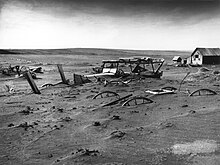
Buried machinery in a barn lot; South Dakota, May 1936. The Dust Bowl on the Great Plains coincided with the Great Depression.[68]
South Africa
Main article: Great Depression in South Africa
As world trade slumped, demand for South African agricultural and mineral exports fell drastically. The Carnegie Commission on Poor Whites had concluded in 1931 that nearly one third of Afrikaners
lived as paupers. It is believed that the social discomfort caused by
the depression was a contributing factor in the 1933 split between the
"gesuiwerde" (purified) and "smelter" (fusionist) factions within the National Party and the National Party's subsequent fusion with the South African Party.[69] Eventually, the gesuiwerde faction of Daniel Malan would go on to form its own party and take over the government after the 1948 election, bringing about the apartheid system of racial segregation which would see an end only in 1994.Sweden
Main article: Economy of Sweden
Taking place in the midst of a short-lived government and a
less-than-a-decade old Swedish democracy, events such as those
surrounding Ivar Kreuger (who eventually committed suicide) remain infamous in Swedish history. Eventually, the Social Democrats under Per Albin Hansson would form their first long-lived government in 1932 based on strong interventionist and welfare state policies, monopolizing the office of Prime Minister until 1976 with the sole and short-lived exception of Axel Pehrsson-Bramstorp's
"summer cabinet" in 1936. During forty years of hegemony, it was the
most successful political party in the history of Western liberal
democracy.[70]Thailand
In Thailand, then known as the kingdom of Siam, the Great Depression contributed to the end of the absolute monarchy of King Rama VII in the Siamese revolution of 1932.United Kingdom
Main article: Great Depression in the United Kingdom
The effects on the northern industrial areas of Britain were
immediate and devastating, as demand for traditional industrial products
collapsed. By the end of 1930 unemployment had more than doubled from 1
million to 2.5 million (20% of the insured workforce), and exports had
fallen in value by 50%. In 1933, 30% of Glaswegians
were unemployed due to the severe decline in heavy industry. In some
towns and cities in the north east, unemployment reached as high as 70%
as ship production fell 90%.[71] The National Hunger March of September–October 1932 was the largest[72] of a series of hunger marches
in Britain in the 1920s and 1930s. About 200,000 unemployed men were
sent to the work camps, which continued in operation until 1939.[73]In the less industrial Midlands and South of England, the effects were short-lived and the later 1930s were a prosperous time. Growth in modern manufacture of electrical goods and a boom in the motor car industry was helped by a growing southern population and an expanding middle class. Agriculture also saw a boom during this period.[74]
See also: North-South divide (England)
United States
Main articles: Great Depression in the United States and New Deal

Shacks, put up by the Bonus Army
(World War I veterans) on the Anacostia flats, Washington, D.C.,
burning after the battle with the 1,000 soldiers accompanied by tanks
and machine guns, 1932.[75]

Bennett buggies, or "Hoover wagons", cars pulled by horses, were used by farmers too impoverished to purchase gasoline.
Shortly after President Roosevelt was inaugurated in 1933, drought and erosion combined to cause the Dust Bowl, shifting hundreds of thousands of displaced persons off their farms in the Midwest. From his inauguration onward, Roosevelt argued that restructuring of the economy would be needed to prevent another depression or avoid prolonging the current one. New Deal programs sought to stimulate demand and provide work and relief for the impoverished through increased government spending and the institution of financial reforms. The Securities Act of 1933 comprehensively regulated the securities industry. This was followed by the Securities Exchange Act of 1934 which created the Securities and Exchange Commission. Though amended, key provisions of both Acts are still in force. Federal insurance of bank deposits was provided by the FDIC, and the Glass–Steagall Act. The institution of the National Recovery Administration (NRA) remains a controversial act to this day. The NRA made a number of sweeping changes to the American economy until it was deemed unconstitutional by the Supreme Court of the United States in 1935.
- Instituting regulations to fight deflationary "cut-throat competition" through the NRA.
- Setting minimum prices and wages, labor standards, and competitive conditions in all industries through the NRA.
- Encouraging unions that would raise wages, to increase the purchasing power of the working class.
- Cutting farm production to raise prices through the Agricultural Adjustment Act and its successors.
- Forcing businesses to work with government to set price codes through the NRA.
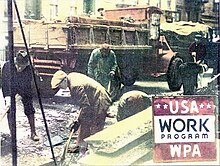
WPA employed 2-3 million unemployed at unskilled labor.
Political consequences
The crisis had many political consequences, among which was the abandonment of classic economic liberal approaches, which Roosevelt replaced in the U.S. with Keynesian policies. These policies magnified the role of the federal government in the national economy. Between 1933 and 1939, federal expenditure tripled, and Roosevelt's critics charged that he was turning America into a socialist state.[88] The Great Depression was a main factor in the implementation of social democracy and planned economies in European countries after World War II (see Marshall Plan). Although Austrian economists had challenged Keynesianism since the 1920s, it was not until the 1970s, with the influence of Milton Friedman that the Keynesian approach was politically questioned.[89]Literature
The Great Depression has been the subject of much writing, as authors have sought to evaluate an era that caused financial as well as emotional trauma. Perhaps the most noteworthy and famous novel written on the subject is The Grapes of Wrath, published in 1939 and written by John Steinbeck, who was awarded both the Nobel Prize for literature and the Pulitzer Prize for the work. The novel focuses on a poor family of sharecroppers who are forced from their home as drought, economic hardship, and changes in the agricultural industry occur during the Great Depression. Steinbeck's Of Mice and Men is another important novel about a journey during the Great Depression. Additionally, Harper Lee's To Kill a Mockingbird is set during the Great Depression. Margaret Atwood's Booker prize-winning The Blind Assassin is likewise set in the Great Depression, centering on a privileged socialite's love affair with a Marxist revolutionary. The era spurred the resurgence of social realism, practiced by many who started their writing careers on relief programs, especially the Federal Writers' Project in the U.S.[91][92][93][94]And the great owners, who must lose their land in an upheaval, the great owners with access to history, with eyes to read history and to know the great fact: when property accumulates in too few hands it is taken away. And that companion fact: when a majority of the people are hungry and cold they will take by force what they need. And the little screaming fact that sounds through all history: repression works only to strengthen and knit the repressed.
Naming
Further information: Depression (economics)
The term "The Great Depression" is most frequently attributed to British economist Lionel Robbins, whose 1934 book The Great Depression is credited with formalizing the phrase,[95] though Hoover is widely credited with popularizing the term,[95][96]
informally referring to the downturn as a depression, with such uses as
"Economic depression cannot be cured by legislative action or executive
pronouncement", (December 1930, Message to Congress) and "I need not
recount to you that the world is passing through a great depression",
(1931).The term "depression" to refer to an economic downturn dates to the 19th century, when it was used by varied Americans and British politicians and economists. Indeed, the first major American economic crisis, the Panic of 1819, was described by then-president James Monroe as "a depression",[95] and the most recent economic crisis, the Depression of 1920–21, had been referred to as a "depression" by then president Calvin Coolidge. Financial crises were traditionally referred to as "panics", most recently the major Panic of 1907, and the minor Panic of 1910–1911, though the 1929 crisis was called "The Crash", and the term "panic" has since fallen out of use. At the time of the Great Depression, the term "The Great Depression" was already used to referred to the period 1873–96 (in the United Kingdom), or more narrowly 1873–79 (in the United States), which has retroactively been renamed the Long Depression.
Other "great depressions"
Other economic downturns have been called a "great depression", but none had been as widespread, or lasted for so long. Various nations have experienced brief or extended periods of economic downturns, which were referred to as "depressions", but none have had such a widespread global impact.British economic historians used the term "great depression" to describe British conditions in the late 19th century, especially in agriculture, 1873–1896, a period now referred to as the Long Depression.[97]
The fall of communism in the Soviet Union led to a severe economic crisis and catastrophic fall in the standards of living in the 1990s in the former Eastern Bloc, most notably, in post-Soviet states,[98] that was almost twice as intense as the Great Depression had been in the countries of Western Europe and the U.S. in the 1930s.[99][100] Even before Russia's financial crisis of 1998, Russia's GDP was half of what it had been in the early 1990s,[100] and some populations are still poorer as of 2009 than they were in 1989, including Ukraine, Moldova, Serbia, Central Asia, and the Caucasus.
Some journalists and economists have taken to calling the late-2000s recession the "Great Recession" in allusion to the Great Depression.[101][102][103][104]
Sumber : http://en.wikipedia.org/wiki/Great_Depression



